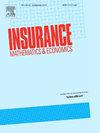精算应用中数据丰富的经济预测
IF 2.2
2区 经济学
Q2 ECONOMICS
引用次数: 0
摘要
随着大数据、机器学习和人工智能(AI)技术的出现,精算师现在可以在数据丰富的环境中开发先进的模型,以实现更好的预测性能,并在许多应用程序中提供附加价值。传统上,精算应用的经济预测是使用基于小数据集的计量经济模型开发的,这些数据集只包括目标变量(通常在4-6左右)及其滞后变量。本文利用一个大数据集——圣路易斯联邦储备银行(FRED)数据库,探讨了利用深度学习进行经济预测的价值,该数据库由121个经济变量及其滞后变量组成,涵盖全球金融危机(GFC)之前、期间和之后以及COVID(2019-2021)期间。本文考虑的四个目标变量包括通货膨胀率、利率、工资率和失业率,这是社会保障基金预测中常用的变量。提出的“PCA- net”模型结合了主成分分析(PCA)和神经网络(包括卷积神经网络(CNN)、长短期记忆(LSTM)和全连接层)的降维方法。PCA-Net通常优于基于向量自回归(VAR)和Wilkie-like模型的基准模型,尽管其优势的大小因经济变量和预测范围而异。利用保形预测,给出预测区间,量化预测的不确定性。通过一个社会保障基金预测应用验证了模型的性能。本文章由计算机程序翻译,如有差异,请以英文原文为准。
Data-rich economic forecasting for actuarial applications
With the advent of Big Data, machine learning, and artificial intelligence (AI) technologies, actuaries can now develop advanced models in a data-rich environment to achieve better forecasting performance and provide added value in many applications. Traditionally, economic forecasting for actuarial applications is developed using econometric models based on small datasets including only the target variables (usually around 4-6) and their lagged variables. This paper explores the value of economic forecasting using deep learning with a big dataset, Federal Reserve Bank of St Louis (FRED) database, consisting of 121 economic variables and their lagged variables covering periods before, during, and after the global financial crisis (GFC), and during COVID (2019-2021). Four target variables considered in this paper include inflation rate, interest rate, wage rate, and unemployment rate, which are common variables for social security funds forecasting. The proposed model “PCA-Net” combines dimension reduction via principal component analysis (PCA) and Neural Networks (including convolutional neural network (CNN), Long Short-Term Memory (LSTM), and fully-connected layers). PCA-Net generally outperforms the benchmark models based on vector autoregression (VAR) and Wilkie-like models, although the magnitude of its advantage varies across economic variables and forecast horizons. Using conformal prediction, this paper provides prediction intervals to quantify the prediction uncertainty. The model performance is demonstrated using a social security fund forecasting application.
求助全文
通过发布文献求助,成功后即可免费获取论文全文。
去求助
来源期刊

Insurance Mathematics & Economics
管理科学-数学跨学科应用
CiteScore
3.40
自引率
15.80%
发文量
90
审稿时长
17.3 weeks
期刊介绍:
Insurance: Mathematics and Economics publishes leading research spanning all fields of actuarial science research. It appears six times per year and is the largest journal in actuarial science research around the world.
Insurance: Mathematics and Economics is an international academic journal that aims to strengthen the communication between individuals and groups who develop and apply research results in actuarial science. The journal feels a particular obligation to facilitate closer cooperation between those who conduct research in insurance mathematics and quantitative insurance economics, and practicing actuaries who are interested in the implementation of the results. To this purpose, Insurance: Mathematics and Economics publishes high-quality articles of broad international interest, concerned with either the theory of insurance mathematics and quantitative insurance economics or the inventive application of it, including empirical or experimental results. Articles that combine several of these aspects are particularly considered.
 求助内容:
求助内容: 应助结果提醒方式:
应助结果提醒方式:


